The regular East African Airways morning flight to Mombasa took off from the Nairobi West Airport in Kenya, Africa, on February 19, 1951 at 07:00 am. The Lockheed 18 "Lodestar" two engines airplane had 9 passengers, 7 men and 2 woman, and a crew of 2. The weather condition was that of a bright clear sky.
At 07:20 a.m., the plane's radio officer, Dennis W. Merrifield, called the pilot, Captain Bicknell, to draw his attention to a bright object like a white star or light, suspended in the sky about 10,000 ft, near Mount Kilimanjaro. The two observed the UFO for 3 minutes before calling it to the attention of the passengers. One of the passengers then proceeded to scrutinize it with a pair of powerful navy binoculars. Meanwhile the radio operator hurried off a description of the object and a resume of the encounter to Eastleigh, the nearest reception station.
The sighting was reported in the newspaper The Nairobi Sunday Post, in their February 25, 1951, issue, including statements by Captain Jack Bicknell:
"The Lodestar plane left Nairobi West at 7:00 a.m. At 7:20 a.m., the radio officer drew my attention to a bright object like a white star hanging motionless about 10,000 feet above Kilimanjaro. My first reaction was to say nothing. We watched it for three minutes. Then we told the passengers about it. One of them had a very powerful pair of binoculars with him and he began to study it. In the meantime, we put a radio message through to Eastleigh describing it. Eastleigh asked us to check whether it was a meteorological balloon. I then examined it for several minutes through the binoculars."
"Through the glasses, I saw a metallic, bullet shaped object which must have been over 200 feet long. At one end was a square-cut vertical fin. Its color was a dull silver, and at regular intervals along the fuselage were vertical dark bands. Its whole outline was clear and sharp and there was no haziness about it at all."
The passenger who had binoculars was an American, Captain H. B. Fussell, ret., a Newport, Monmouthshire, sports dealer. He reported:
"Through the glasses the object appeared bullet-shaped. The color was whitish-silver with three vertical black bands down the side. For 10 minutes it remained stationary, then it suddenly rose vertically by 5,000 ft. Again it became stationary, then a minute later, it rose again and moved laterally away at great speed, probably 400 mph."
When confronted with the theory that it might have been a balloon, Captain Fussell rejected that explanation:
"How could a balloon hover motionless and move at 400 mph in the same weather conditions? The object was definitely metallic."
Another passenger was a radio officer from the American freighter Robin Mowbray. He said:
"I couldn't swear to it but through the binoculars I thought I could identify a row of circular windows."
This passenger was accompanied by Charles J. Vernon, purser of the Robin Mowbray and also an American who said:
"The object must have been immense, two or three times the size of the largest passenger plane."
The suggestion that it was a balloon was thus eliminated. The Lodestar occupants continued to examine the clearly defined, bullet-shaped unknown. Three attempts were made to take photographs of the object. Charles J. Vernon photographed it, Captain Fussell took a picture with his miniature camera, and radio officer Overstreet shot 30 feet of color film with a telescopic lens on his cine camera.
After landing at Mombasa, Captain Fussell developed his film in the presence of a newspaper reporter and a commercial photographer, who could certify that the film was not faked or retouched. Three of his shots showed nothing and the fourth showed a small dark object. The shots by Charles Vernon showed nothing. Overstreet's film could not be developed immediately, color movie demanding a development facility that wasn't available. According to the newspaper Natal Mercury, "a passenger" took a film, that, when it was developed, did show a clear and sizeable image of the object.
Bicknell said that as the plane was some 50 miles from Mount Kilimanjaro:
"It was absolutely stationary, and remained that way for 17 minutes."
And:
"I timed the object for 17 minutes while the Lodestar held its course. Twice it rose vertically to a final height of 40,000 ft. (12,500 metres), then it moved east towards the coast at a terrific speed."
And:
"Then it began to move eastwards, rising as it did so. It disappeared at about 40,000 feet. The machine left no vapor trail, and it had no visible means of propulsion."
"My impression was that it was definitely a flying machine of some kind."
At some later date, both Bicknell and Merrifield stated that they felt the object was a craft of some sort, and Merrifield said that it must have been a machine ...
"... 500 years ahead of its time."
Bicknell made the following drawing of the object in the affidavit he immediately prepared after landing at Mombasa, which Merrifield and all the nine passengers signed:

|
The balloon or cloud possibility was definitely eliminated when after 17 minutes, the UFO began to rose, reaching a speed that was evaluated as about 1.000 miles per hour, and it disappeared from sight into the upper, cloudless sky.
Reporter Richard Heiden detailed the story and indicated that all nine passengers and the crew signed an affidavit giving a very clear report.
There was some mystery on the whereabouts of the film shot by Overstreet: Captain Bicknell said that he later learned that Overstreet was on his way to the United States to show the film to the authorities there. He said the name of the ship on which he was traveling was mentioned to him at the time, as well as the date of his expected arrival. But in spite of repeated requests from him for further news, he never managed to get any news as to the whereabouts of Overstreet and his color film.
The Natal Mercury newspaper in Durban, South Africa, had published both a story about the sighting and, it is believed, a photograph of the UFO, which was said to come from Ray Overstreet film of the object. Debunker James Moseley said there was no mystery to the film's fate: "The film exists; it was examined by the US Air Force. It was found to be little more than a bouncing bit of light and was returned."
Forty years later, African ufologist Cynthia Hind tried to locate the witnesses again. She reported:
I have tried through several people, as well as through letters to the newspapers in Durban, to contact Capt. Bicknell or anyone who knew him, but have met with no success. The event occurred in 1951, some 40 years ago. If Bicknell was in his mid-thirties then, he will be close to 80 if he is still alive. He may not want to emerge from his anonymity now. It seems a shame that with all the excellent observers on that day, the case was never fully investigated at the time.
I recall submitting an article to Dennis Stacy of the MUFON Journal on shapes sighted in Africa. He was quite excited at the 'exotic' shapes that he anticipated, but of course Africa, with a few exceptions, is no different from anywhere else. So, the article never saw the light of day.
But all this merely underlines my belief. The factor that proves to me that UFOs exist, is that they are the same the world over, and only when viewed in the context of a particular country's culture, is there any difference at all.
The article in "Flying saucers and Common Sense" told:
Flying in a cloudless sky over Mount Kilimanjaro, in Tanganyika, Captain Jack Bicknell, pilot of a passenger plane bound for Mombasa, saw through binoculars "a metallic, bullet-shaped object which must have been more than 200 feet long." The Sunday Dispatch last week gave a detailed report of this flying saucer sighting, the most authentic so far recorded.
When he brought the plane down, Captain Bicknell drew a sketch of what he had seen.
The diagram shown above [sketch reproduced in this article] was prepared by Captain Bicknell and shows the "large object attached to the rear."
One passenger, Captain H. B. Fussel, of Newport, Monmouthshire, also told of the "three vertical black bands down the side."
Captain Bicknell, an ex-BOAC pilot, giving additional details, said the mystery object was stationary when first seen, and remained so for 17 minutes.
"Then it began moving eastwards, rising as it did so. It disappeared at about 40.000 feet," he said.
"We've calculated that in the three minutes of visible movement it covered about 60 miles. That gives it a speed of well over 1.000 mph."
An unreferenced newspaper article that was in the US Air Force Blue Book file told:
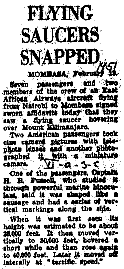
|
Mombasa, February 19
Seven passengers and two members of the crew of an East African Airways aircraft flying from Nairobi to Mombasa signed a sworn affidavit today that they saw a flying saucer hovering over Mount Kilimanjaro.
Two American passengers took cine camera pictures with telephoto lenses and another photographed it with a miniature camera.
One of the passengers, Captain H. B. Fussel, who studied it though powerful marine binoculars, said it was shaped like a sausage and had a series of vertical markings along the side.
When it was first seen, its height [altitude] was estimated to be about 25.000 feet. It then moved vertically to 30.000 feet, hovered a short while and then rose again to 40.000 feet. Later it moved off laterally at "terrific speed."
Another unreferenced newspaper article that was in the US Air Force Blue Book file reads:
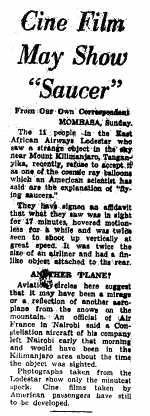
|
From Our Own Correspondent
MOMBASA, Sunday.
The 11 people in the East African Airways Lodestar who saw a strange object in the sky near Kilimanjaro, Tanganyika, recently, refuse to accept it was one of the cosmic ray balloons which an American scientist has said was the explanation of "flying saucers."
They have signed an affidavit that what they saw in sight for 17 minutes hovered motionless for a while and was twice seen to shoot up vertically at great speed. It was twice the size of an airliner and had a fin-like object attached to the rear.
ANOTHER PLANET
Aviation circles here [in U-K.] suggest it may have been a mirage or a reflection of another aeroplane from the snows on the mountain. An official of Air France in Nairobi said a Constellation aircraft of his company left Nairobi early that morning and would have been in the Kilimanjaro area about the time the object was sighted.
Photographs taken from the Lodestar show only the minutest speck. Cine films taken by American passengers have still to be developed.
The London Sunday Dispatch for February 25, 1951, published this article:
Nine men and two women who saw a mystery object flying near Mount Kilimanjaro, Tanganyika, last week, have signed an affidavit giving the most authentic Flying Saucer report so far.
They saw the mystery object clearly for seventeen minutes from their plane, and describe it as bullet-shaped and metallic.
They refuse to accept the explanation of Dr. U. Liddel, U.S. research chief, who says flying saucers are "Skyhook" experimental balloons. Here is a detailed account of what they saw.
The object was first seen by Radio Operator Dennis W. Merrifield, 54, in the East African Airways plane Lodestar, en route to Mombasa from Nairobi.
"Have a look at a flying saucer," he said to Captain B.J. Bicknell, 30, an ex-BOAC pilot.
The object was absolutely motionless 10,000 feet above Kilimanjaro. Merrifield, an ex-R.A.F, radioed Nairobi that the object was a "bright gleaming spot."
Nairobi reported that there were no other planes in a wide arc and said: "Take more water with it."
Captain Bicknell told me: "The morning was clear and cloudless, visibility was good and the weather perfect. I timed the saucer for seventeen minutes while the Lodestar kept to its course. Twice it rose vertically to a final height of 40,000 feet, then, it moved east towards the coast at a terrific speed.
"There was a large, fin-like object attached to the rear, although it wasn't clearly defined. There was no apparent propelling power when the saucer moved. There were definitely no vapor trail."
One passenger, Captain H.B. Fussell, a Newport, Monmouthshire, sports dealer, who had a pair of powerful binoculars said: "Through the glasses the object appeared bullet-shaped. Its color was whitish-silver with three vertical black bands down the side. For ten minutes it remained stationary, then, it suddenly rose vertically by 5,000 feet."
"Again if became stationary, and then a minute later it rose, again and moved laterally away at great speed, probably 400 m.p.h."
Captain Fussell said that Dr. Urner Liddel's balloon theory did not fit what he saw. "Suppose it was a balloon - How could a balloon both hover motionless and move at 400 m.p.h. in the same weather conditions?" he asked.
"I emphatically reject the theory. The object was definitely metallic."
A radio officer named Overstreet from the American freighter Robin Mowbray, who was another passenger, said: "I wouldn't swear but through the binoculars I thought I could identify a row of circular windows."
Charles J. Vernon, also American and purser of the Robin Mowbray, said: "The object must have been immense, two or three times the size of the largest passenger planes."
Three separate attempts to photograph the object were made from the plane. Captain Fussell snapped it with his miniature camera. Mr. Overstreet shot 30 feet of color film with a telescopic lens on his cine-camera, and Mr. Vernon also tried to snap it.
After landing, Captain Fussell developed his film in the presence of a newspaper reporter and a commercial photographer, who could certify that the film was not faked or retouched.
Three exposures were blank but the fourth showed a small black object. Mr. Vernon's film showed nothing, and Mr. Overstreet's 8 color-film has not yet been developed.
During the night, after the saucer was reported, two unexplained flashed lit Mombasa. Captain Bicknell was born in Exeter and lived in London before joining the Eastern Africa Airways in 1948. Radio operator Merrifield's parents live at Allison Gardens, Southall, Middlesex.
The article "Flying saucers and Common Sense" said:
Flying in a cloudless sky over Mount Kilimanjaro, in Tanganyika, Captain Jack Bicknell, pilot or passenger plane bound for Mombasa, saw through binoculars "a metallic, bullet-shaped object which must have been more than 200 feet long." The Sunday Dispatch last week gave a detailed report of this flying saucer sighting, the most authentic so far recorded.
When he brought the plane down, Captain Bicknell drew a sketch of what he had seen.
The diagram shown above [sketch reproduced in this article] was prepared by Captain Bicknell and shows the "large object attached to the rear."
One passenger, Captain H. B. Fussel, of Newport, Monmouthshire, also told of the "three vertical black bands down the side."
Captain Bicknell, an ex-BOAC pilot, giving additional details, said the mystery object was stationary when first seen, and remained so for 17 minutes.
"Then it began moving eastwards, rising as it did so. It disappeared at about 40.000 feet," he said.
"We've calculated that in the three minutes of visible movement it covered about 60 miles. That gives it a speed of well over 1.000 mph.
One very interesting item of information on the case appeared in the Australian Flying Saucer Magazine, by the Australian Flying Saucers Bureau, in May 1953:
THE MOUNT Kilimanjaro INCIDENT
FEBRUARY 19, 1951 at Nairobi, Kenya Colony, East Africa
At Nairobi West airport, the regular Monday morning Lodestar was readied as usual for its morning flight to Mombasa, and soon passengers filed aboard little dreaming, any of them, of what was to meet their astounded eyes barely 20 minutes later.
At 7 a.m., exactly, with 9 passengers and a crew of 2 aboard, the Lodestar took off.
All went well until 7:20 a.m., when suddenly the radio officer drew the attention of his superior, Captain J. Bicknell, to a bright object like a white star, apparently hanging motionless easily 10.000 feet above Mount Kilimanjaro.
Captain Bicknell's first reaction, he said later, was to say nothing. The two watched the strange object for three minutes, then, as it showed no sign of vanishing, informed the passengers. One began promptly studying the oddity amazedly through a powerful pair of fieldglasses, whilst the radio officer flashed an excited call to Eastleigh nearby, giving an account and description of this thing.
Eastleigh's suggestion flashed in return was that the object might be a drifting meteorological balloon, but checking on that possibility, after inspecting the enigmatic object for several minutes, Captain Bicknell found that the more he examined it, the less it could possibly be mistaken for a balloon. It was a dull silver color, and marked at regular intervals along the fuselage with vertical dark bands. The entire outline, he found, was unmistakingly distinct, nor, though it appeared to be incredibly distant, was its sharp outline obscured in the least detail by intervening haze.
Captain Bicknell estimated the thing was over 200 feet long, bullet-shaped, and apparently constructed of metal which shone brightly. On first sighting it, the Lodestar was heading roughly towards it, and watched it closely as they approached. Captain Bicknell perceived another detail. The thing possessed a square-cut vertical fin at one end. There was no sign of movement, it was absolutely stationary.
SO IT REMAINED FOR 17 MINUTES.
Passengers of the Lodestar were now taking turns with the field glasses, and two of them had commenced taking photographs, when suddenly the enormous thing began to move westwards, slowly at first and rising as it did so. Before it reached 40.000 feet, at which point it was ultimately lost sight of, the sides of the awesome, whale-sized object were seen clearly to be without a break in their smoothness, nor windows or portholes relieved the harsh purity of line, no engine mounts or jet pods warred the perfectly streamlined hull.
The day being exceptionally clear, there was no cloud formation in evidence anywhere, and Captain Bicknell calculated that in the three minutes of visible movement, the bullet-shaped object covered 60 miles; that in other words, its speed could have been nothing short of 1.000 mph during the period of observed flight. It left behind no vapour trail, and to all who saw it, had no visible means of propulsion.
During an interview some days later, Captain Bicknell said that his impression was that the unidentified thing was some kind of flying machine, and with this his radio officer, A Mr. D.W. Merrifield, unhesitantly agreed. A "mirage" was suggested as the possible cause, but the radio officer discounted it. "Mirage are rarely seen without clouds," he stated, "nor would that explain the object's movement." He commented that if the object was a flying machine, it was 500 years ahead of anything we have today.
Nairobi "Sunday Post" the following Monday said: "If this report had come from a few isolated individuals it would soon be discounted. But it came from responsible airline officials and nine ordinary travelers." It too dismissed both the balloon and mirage theories, and concluded that hopes of a "natural" explanation had begun to fade. Other theories ranged from Martian visitors to radio-controlled weapons.
Fragmentary evidence secured since then increase the sum total of knowledge but little. U.S. "Life" magazine early in 1952 published a sketch of the object, which showed it to resemble an ordinary lipstick tube lying on its side. More recently, in connection with learning the whereabouts of the photographs taken form Captain Bicknell's plane, the Australian Flying Saucer Bureau learnt that the only known public photograph of the object shows a blurred spot on the film. A motion picture film taken by another passenger was "quite clear" we learn, but the same reliable source stated "either laconically or ominously, it is hard to tell which, that the man with the film is supposed to have disappeared."
So the case stands, at present, one of the most puzzling and enigmatic unexplained fling saucer sighting recorded in A.F.S.B. files.
EDITOR'S NOTE
In regard to the above incident, we received the following reply, to our inquiry, dated 25th October, 1952 from the East African Airways Corporation:
"I have received your letter of 16th October, 1952, but regret that the photographs required by you are not available within the East African Airways Corporation. They were, I believe, taken by a passenger traveling in the aircraft, whose name cannot now be traced."
"I should point out that there was always been considerable doubt as to the truth of the report. The photograph was never published, and after developing, there was no trace of any phenomena on the print. Rumour has it that when they were developed, the chemist obliterated the spots, thinking they were a fault on the negative."
"I am sorry that I cannot be more helpful, but as I have said, the photographs are non existent."
Yours Faithfully,
H.C.K. Downes
PUBLICITY OFFICER
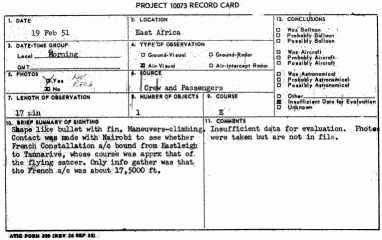
|
| Was balloon | |
| Probably balloon | |
| Possibly balloon | |
| Was aircraft | |
| Probably Aircraft | |
| Possibly aircraft | |
| Was astronomical | |
| Probably astronomical | |
| Possibly astronomical | |
| Other ___ | |
| X | Insufficient Data for Evaluation |
| Unknown |
| 3. DATE-TIME GROUP Local: Morning GMT: __ |
4. TYPE OF OBSERVATION Air visual |
|
| 5. PHOTOS Yes Not seen |
6. SOURCE Crew and Passengers |
|
| 7. LENGTH OF OBSERVATION 17 min |
8. NUMBER OF OBJECTS 1 |
9. COURSE E |
|
10. BRIEF SUMMARY OF SIGHTING Shape like bullet with fin. Maneuvers-climbing. Contact was made with Nairobi to see whether French Constellation aircraft bound from Eastleigh to Tananarive, whose course was approximately that of the flying saucer. Only info gathered was that the French aircraft was about 17,000 ft. |
11. COMMENTS Insufficient data for evaluation. Photos were taken but are not in file. |
|
Blue Book did not particularly investigate the case and indicated that they did not get to see the photos or the film, and wrote it off as unexplained due to insufficient data. It is apparent that their information on the case as reported on the card is what they read on the information sheet sent by the US consulate in Dar es Salaam, which is the only government document additional to the record card in the Project Blue Book file (there are also newspaper articles and a copy of the A.F.S.B article in their file).
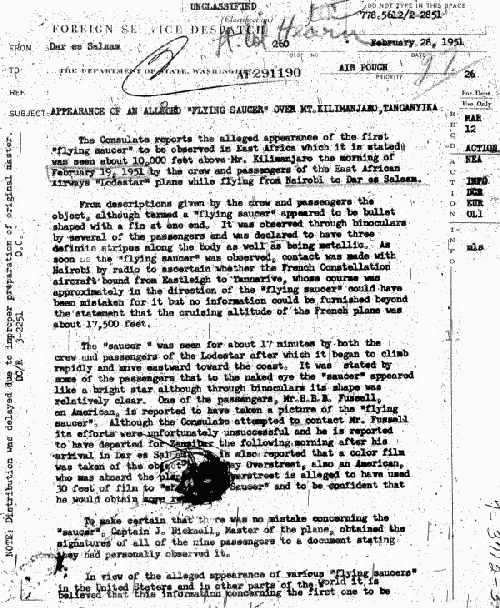
|
FOREIGN SERVICE DISPATCH
FROM Dar es Salaam - February 28, 1951.
TO THE DEPARTMENT OF STATE, WASHINGTON D.C.
SUBJECT APPEARANCE OF AN ALLEGED "FLYING SAUCER" OVER MT Kilimanjaro, TANGANYIKA
The Consulate reports the alleged appearance of the first "flying saucer" to be observed in East Africa which it is stated was seen about 10.000 feet above Mt. Kilimanjaro the morning of February 19, 1951 by the crew and the passengers of the East African Airways "Lodestar" plane while flying from Nairobi to Dar es Salaam.
From descriptions given by the crew and the passengers the object, although termed a "flying saucer" appeared to be bullet shaped with a fin at one end. It was observed though binoculars by several of the passengers and was declared to have three definite stripes along the body as well as being metallic. As soon as the "flying saucer" was observed, contact was made with Nairobi by radio to ascertain whether the French Constellation aircraft bound from Eastleigh to Tananarive, whose course was approximately in the direction of the "flying saucer" could have been mistaken for it but no information could be furnished beyond the statement that the cruising altitude of the French plane was about 17.000 feet.
The "saucer" was seen for about 17 minutes by both the crew and passengers of the Lodestar after which it began to climb rapidly and move eastward toward the coast. It was stated by some of the passengers that to the naked eye the "saucer" appeared like a bright star although through binoculars its shape was relatively clear. One of the passengers, Mr. H.B.K. Fussel, an American, is reported to have taken a picture of the "flying saucer". Although the consulate attempted to contact Mr. Fussel its effort ere unfortunately unsuccessful and he is reported to have departed from Zanzibar the following morning after his arrival in Dar es Salaam. It is also reported that a color film was taken of this object by [...] Overstreet, also an American, who was aboard the plane. Mr. Overstreet is alleged to have used 30 feet of film to "[...] the saucer" and to be confident that he would obtain some [reward?]
To make certain that there was no mistake concerning the "saucer", Captain J. Bicknell, Master of the plane, obtained the signature of all the nine passengers to a document stating they had personally observed it.
In view of the alleged appearance of various "flying saucers" in the United States and in other parts of the world it is believed this information concerning the first one to be [next page, "seen in East Africa and may be of interest to the department", plus signatures.]
Explanations such as mirage, lenticular cloud above Mount Kilimanjaro, "reflection of a plane in the snow" and balloon, make no sense at all. The notion of Skyhook balloon was discussed because just earlier, an American scientist, Urner Liddel, made the silly statement that all flying saucer reports are caused by Skyhook balloon. This was not imply innocent incompetence: in an confidential memo, the US Air Force had just asked their involved personal to tell the Press that UFOs are balloon or astronomical phenomena, and some of the personal just did that. Dr. Urner Liddel, chief of the nuclear physics branch of the Office of Naval Research, was of course aware of the Navy's high altitude Skyhook balloons project and was quoted just days before this sighting and all over the world Press saying all UFOs are balloon (See for example The Evening Telegraph for February 13, 1951).
If there is a commonplace explanation, the least silly would be that of the regular flight French Air France Lockheed Super Constellation plane en route to Madagascar (picture underneath). Most recent ufological sources make no mention of the Constellation that was supposed to fly at the place and time of the sighting. From the original sources, it appears that the crew did not overlook this candidate explanation. It was the explanation that first came up to the crew, as they asked ground control to tell them if the Constellation was in the area. It is however not certain that this plane is the correct commonplace explanation of the sighting: the three vertical bands, that lack of engine mounts, that are described clearly at least by two of the witnesses, the description being signed by all witnesses, does not fit well this explanation very well. There is very little chance that the Constellation could appear to hover for a time reported of at least 10 minutes. Then, if the estimates and calculations of the crew are correct, the speed of the seen object is much too important for a Constellation. It seems obvious that the crew eliminated the possibility of the Constellation when the object started to maneuver fast upwards. One the other end, the Constellation has three rudders, and the possibility that a Constellation was seen from the back, with reflective wings and the three fins appearing as the three vertical bands reported, should not be overlooked. This interpretation however lets the reported and drawn fin unexplained.
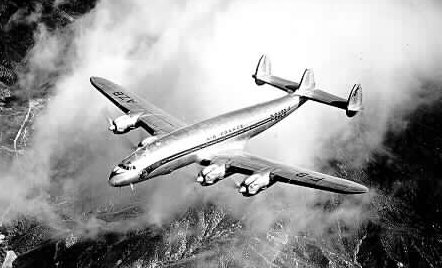
|
As often, the different photographic records seem to be lost for research now. However, given the distance of the object, the fact that the witnesses had to use binoculars to see its details, it is very likely that the photographic records and the movie did not show much more than a spec. Cinema camera in 1951 did not have the kind of definition to make out much details, and, being probably handheld, the image was probably shaky altogether. It is interesting to note that the Airline official who answered the Australian Flying Saucer Bureau told that one of the pictures showed a spec that the chemist wiped out thing it was a stain. Wacky ufologist and occasional hoaxer James Moseley seemed to have claimed that the US Air Force had seen the film, but this is not supported by their documentation that shows they only knew what the US Consulate in Dar es Salaam reported on the case, and that they did not get to see any photograph or film.
However, it is a pity that no serious investigation was made at the time. With the number of witnesses, the duration of the sighting, either the Constellation explanation was missed, or a potentially very good case has been overlooked. More than 50 years later is probably just too late to get any chance to know.